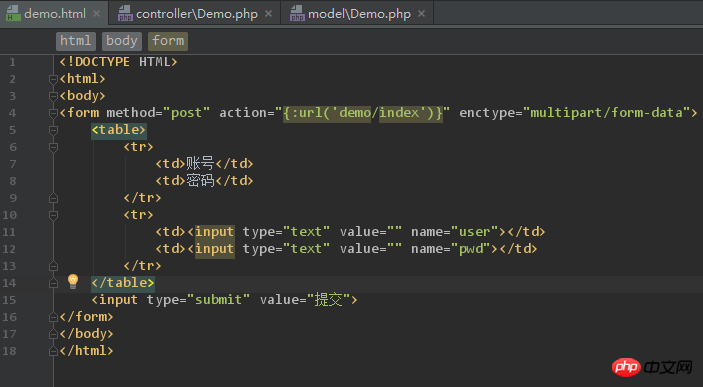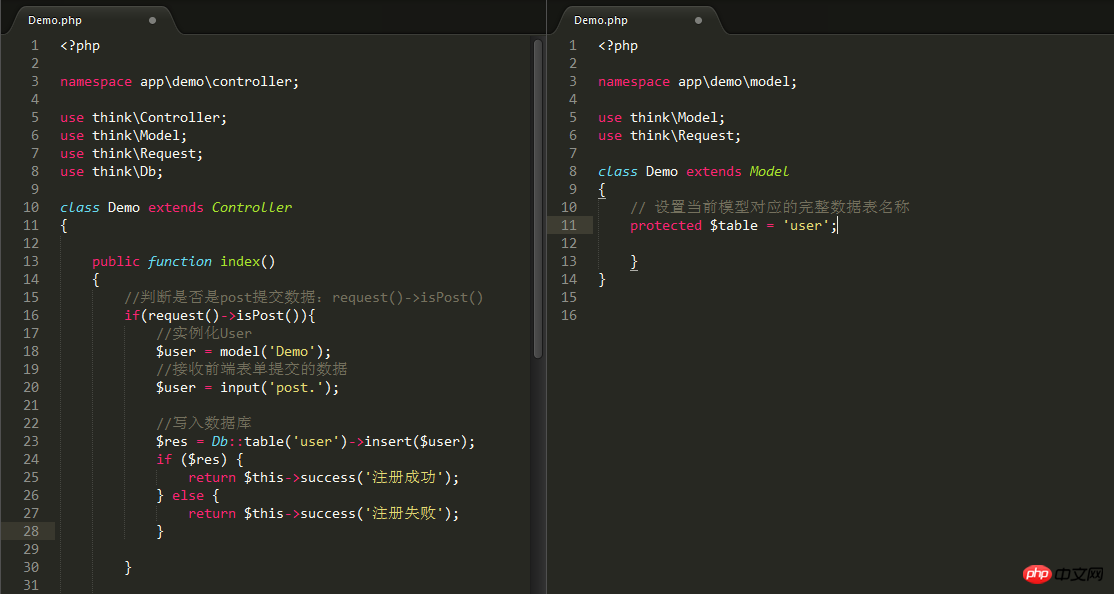 Backend Development
Backend Development
 PHP Tutorial
PHP Tutorial
 How to implement it simply through TP5-Add, Delete, Modify and Check
How to implement it simply through TP5-Add, Delete, Modify and Check
How to implement it simply through TP5-Add, Delete, Modify and Check
TP5--The simple implementation of addition, deletion, modification and search is very important. This article will explain its related operations in detail.
a. Letter functions such as: M, U, I, etc. cannot be used. You can use model, :url(), input() and other assistant functions to operate (attached is a link posted by a kind person on the official website: http://www.thinkphp.cn/topic/42108.html).
b. Get form tuning data: $str=input('post.name'); || ('Transfer method.Field name'). When writing a post. When there is no field name, all the form data is automatically obtained and written into the array.
c. Get the a tag parameter: $str=input('id'); || ('parameter name'). Only write the parameter name in the a tag, and the input assistant function can automatically determine the post or get method.
d. For data processing operations, it is recommended to write the code into the model, and then instantiate the model class through the controller ($test=model('Test');). Then copy and call the corresponding operation method in the model ($res=$test->addTest()). Then use the true||false value passed by the judgment method to perform page jump verification and display.
e. In the controller, data can only be operated through the Db assistant function. Similarly, there is no operation in the model.
f. The model name should be consistent with the data table name, so that the framework will automatically find the corresponding table when performing operations. If the naming is inconsistent, the data table needs to be declared in the model (protected $table='table name'); then directly write (Test::operation name) in the operation.
g. The command line is a good thing (attached is the link: http://www.cnblogs.com/douz/p/6811471.html)
Code example:
View:

1. Add ($user->pwd = md5(input('post.pwd')));)
Method 1: Database operationWritten into the model, the controller only calls the methods in m

Method 2:

Method 3: Use Db assistant function to directly call database operations.

2. Check: The database operation is written into the model, and the controller directly calls the method
//The select() operation of data is performed in the model
public function getUser()
{
$user = Demo::select();
return $user;
}
//Loading the view and transmitting data in the controller
$res = $user->getUser();
//Introducing the view and passing the query Result
return view('\demo',['res'=>$res]);
3. Change
//model Data select() operation
public function edit()
{
if(request()->isGet()){
$ res = Db::table('user')->where('id',input('get.id'))->update(['user' => input('get.user')] ) ;
if($res){
return $this->success('Modification successful');
}else{
return $this->error('Modification failed');
}
}
}
4. Delete: Use Db assistant function to call directly Database operations.
public function del()
{
//return input('id');
if(request()->isGet( )){
$res = Db::table('user')->where('id',input('id'))->delete();
if($res){
return $this->success('Delete successfully');
}else{
return $this->error('Deletion failed');
}
}
}
This article is about TP5-- The simple implementation of adding, deleting, modifying and checking is explained. For more learning materials, please pay attention to the PHP Chinese website to view.
Related recommendations:
How to query the last record through mysql
Related explanations about left join on and where condition placement
The above is the detailed content of How to implement it simply through TP5-Add, Delete, Modify and Check. For more information, please follow other related articles on the PHP Chinese website!

Hot AI Tools

Undresser.AI Undress
AI-powered app for creating realistic nude photos

AI Clothes Remover
Online AI tool for removing clothes from photos.

Undress AI Tool
Undress images for free

Clothoff.io
AI clothes remover

Video Face Swap
Swap faces in any video effortlessly with our completely free AI face swap tool!

Hot Article

Hot Tools

Notepad++7.3.1
Easy-to-use and free code editor

SublimeText3 Chinese version
Chinese version, very easy to use

Zend Studio 13.0.1
Powerful PHP integrated development environment

Dreamweaver CS6
Visual web development tools

SublimeText3 Mac version
God-level code editing software (SublimeText3)

Hot Topics
 1664
1664
 14
14
 1423
1423
 52
52
 1317
1317
 25
25
 1268
1268
 29
29
 1246
1246
 24
24
 Explain JSON Web Tokens (JWT) and their use case in PHP APIs.
Apr 05, 2025 am 12:04 AM
Explain JSON Web Tokens (JWT) and their use case in PHP APIs.
Apr 05, 2025 am 12:04 AM
JWT is an open standard based on JSON, used to securely transmit information between parties, mainly for identity authentication and information exchange. 1. JWT consists of three parts: Header, Payload and Signature. 2. The working principle of JWT includes three steps: generating JWT, verifying JWT and parsing Payload. 3. When using JWT for authentication in PHP, JWT can be generated and verified, and user role and permission information can be included in advanced usage. 4. Common errors include signature verification failure, token expiration, and payload oversized. Debugging skills include using debugging tools and logging. 5. Performance optimization and best practices include using appropriate signature algorithms, setting validity periods reasonably,
 PHP Program to Count Vowels in a String
Feb 07, 2025 pm 12:12 PM
PHP Program to Count Vowels in a String
Feb 07, 2025 pm 12:12 PM
A string is a sequence of characters, including letters, numbers, and symbols. This tutorial will learn how to calculate the number of vowels in a given string in PHP using different methods. The vowels in English are a, e, i, o, u, and they can be uppercase or lowercase. What is a vowel? Vowels are alphabetic characters that represent a specific pronunciation. There are five vowels in English, including uppercase and lowercase: a, e, i, o, u Example 1 Input: String = "Tutorialspoint" Output: 6 explain The vowels in the string "Tutorialspoint" are u, o, i, a, o, i. There are 6 yuan in total
 Explain late static binding in PHP (static::).
Apr 03, 2025 am 12:04 AM
Explain late static binding in PHP (static::).
Apr 03, 2025 am 12:04 AM
Static binding (static::) implements late static binding (LSB) in PHP, allowing calling classes to be referenced in static contexts rather than defining classes. 1) The parsing process is performed at runtime, 2) Look up the call class in the inheritance relationship, 3) It may bring performance overhead.
 What are PHP magic methods (__construct, __destruct, __call, __get, __set, etc.) and provide use cases?
Apr 03, 2025 am 12:03 AM
What are PHP magic methods (__construct, __destruct, __call, __get, __set, etc.) and provide use cases?
Apr 03, 2025 am 12:03 AM
What are the magic methods of PHP? PHP's magic methods include: 1.\_\_construct, used to initialize objects; 2.\_\_destruct, used to clean up resources; 3.\_\_call, handle non-existent method calls; 4.\_\_get, implement dynamic attribute access; 5.\_\_set, implement dynamic attribute settings. These methods are automatically called in certain situations, improving code flexibility and efficiency.
 PHP and Python: Comparing Two Popular Programming Languages
Apr 14, 2025 am 12:13 AM
PHP and Python: Comparing Two Popular Programming Languages
Apr 14, 2025 am 12:13 AM
PHP and Python each have their own advantages, and choose according to project requirements. 1.PHP is suitable for web development, especially for rapid development and maintenance of websites. 2. Python is suitable for data science, machine learning and artificial intelligence, with concise syntax and suitable for beginners.
 PHP in Action: Real-World Examples and Applications
Apr 14, 2025 am 12:19 AM
PHP in Action: Real-World Examples and Applications
Apr 14, 2025 am 12:19 AM
PHP is widely used in e-commerce, content management systems and API development. 1) E-commerce: used for shopping cart function and payment processing. 2) Content management system: used for dynamic content generation and user management. 3) API development: used for RESTful API development and API security. Through performance optimization and best practices, the efficiency and maintainability of PHP applications are improved.
 PHP: A Key Language for Web Development
Apr 13, 2025 am 12:08 AM
PHP: A Key Language for Web Development
Apr 13, 2025 am 12:08 AM
PHP is a scripting language widely used on the server side, especially suitable for web development. 1.PHP can embed HTML, process HTTP requests and responses, and supports a variety of databases. 2.PHP is used to generate dynamic web content, process form data, access databases, etc., with strong community support and open source resources. 3. PHP is an interpreted language, and the execution process includes lexical analysis, grammatical analysis, compilation and execution. 4.PHP can be combined with MySQL for advanced applications such as user registration systems. 5. When debugging PHP, you can use functions such as error_reporting() and var_dump(). 6. Optimize PHP code to use caching mechanisms, optimize database queries and use built-in functions. 7
 The Enduring Relevance of PHP: Is It Still Alive?
Apr 14, 2025 am 12:12 AM
The Enduring Relevance of PHP: Is It Still Alive?
Apr 14, 2025 am 12:12 AM
PHP is still dynamic and still occupies an important position in the field of modern programming. 1) PHP's simplicity and powerful community support make it widely used in web development; 2) Its flexibility and stability make it outstanding in handling web forms, database operations and file processing; 3) PHP is constantly evolving and optimizing, suitable for beginners and experienced developers.



